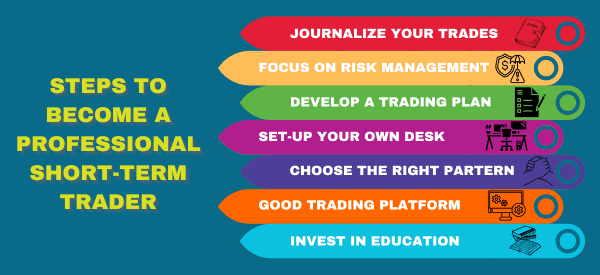The transition from amateur to pro is more difficult than most people imagine.
Take sports, for example. Maybe you’re good at soccer (or “football” for most of the world), golf, or tennis. You bring 100% to every game, and everybody who plays with or against you knows your skills are “next level.”
But that’s not enough—very few amateurs actually have the skills to even consider going pro. Most amateurs play for fun and want to keep it that way.
For short-term trading there’s a similar dilemma, but with a difference. You may have been trading during your free time or breaks at your day job. You have a sharp eye for trends and follow the best traders on YouTube and Instagram.
You may have wondered, “do I have what it takes to become a full-time, professional short-term trader?”
At Real Trading, we know that not everyone wants to become a professional short-term trader. However, we believe that with the right training, tools, and commitment, nearly everyone is capable.
In this step-by-step guide on how to become a professional trader, we’ll explain exactly what separates amateurs from pros, and how you can make the leap.
Table of Contents
Short-Term Trading Amateurs vs. Professionals
There are many visible and intangible qualities that separate amateur traders from professionals.
Here are the most important areas where the two types of traders differ.
Emotional Regulation
Short-term trading is a math-heavy activity, but all the math skills in the world can’t help a trader who, in a heightened emotional state, ignores the data. When trading emotionally, you make costly mistakes, wasting energy and resources.
Professional traders experience emotional swings, but they’ve learned to regulate their passions. They avoid taking decisions under the influence of strong emotions and fall back on their written plan when in doubt.
Strategy
The work of a short-term trader requires consuming a flood of data and information. This can be overwhelming for new traders and often leads to poor decision-making.
Professional traders study the strategies of other successful traders.
They build out their strategies and test them in trading simulators. Each day, a professional trader writes out their plan and sticks to it as much as possible. Even when the markets demand a pivot from the written plan, a professional trader understands how to pivot and why the pivot needs to happen.
Market Knowledge
You don’t have to be an expert in an industry or commodity to successfully trade it.
Nassim Taleb labeled this dynamic the Green Lumber Fallacy, based on an anecdote about a man who traded in green lumber but thought it was just green-painted wood, not uncured lumber. This seemingly fundamental fact about the commodity had nothing to do with his skill as a trader.
It’s not that professional traders are willfully ignorant. They study the assets they trade and the market dynamics that affect the price. Mundane facts about an asset might affect its price, but it’s your job as a short-term trader to figure out which details matter and which details don’t.
Risk Management
New traders may understand the basics of trading risk, such as the potential to lose money. What they need to learn is the science of risk management.
Professional traders study risk management and practice it daily. They build tools such as risk decision matrices and assess their exposure with every trade. A professional trader treats risk as a long-term game won through consistency, not heroics.
Self-Discipline
When traders get their first taste of a winning trade, they often get carried away on the emotional high. Conversely, once bitten by loss, a new trader will exit trades because of anxiety. They allow price swings to dictate their decisions instead of trusting a plan and waiting for the opportune moment.
Professional traders have put in the repetitions to know how fickle and misleading the markets can be. They balance the fast-paced decisions required of short-term trading with the long-term objective of maximizing wins and minimizing losses.
The Biggest Short-Term Trading Myth: You Need a Degree
Unfortunately, in the world of short-term trading, myths are aplenty. At Real Trading, we make it a point to separate fact from fiction.
One of those misunderstandings is about education, so we’ll say it loud and clear: nobody needs a formal degree to become a professional short-term trader Period.
Sure, some traders studied finance or another discipline that helped them get a job at a trading firm or strike out on their own.
But many other traders learned the profession on the field. They studied the principles of short-term trading in their free time, read books on the topic, took online courses, and, most importantly, learned by trading in a simulator and with real money.
There’s no substitute for real-world trading experience—a degree from an expensive school has zero influence on the price of a given asset or your ability to make money trading it.
The 7 Steps to Becoming a Professional Short-Term Trader
Now that we got the degree question out of the way, let’s explore the things you can and should do to become a professional short-term trader.

Step 1: Invest in Education
While formal (aka university) education is not a requirement to become a trader, you do need to commit to learning and studying.
Everything you need to know about how to become a professional trader is available online. In fact, at Real Trading, we offer beginner and advanced trading courses to all our members. These courses give you the foundation to start trading and level your skills.
We also recommend that you spend time reading books on short-term trading and learning from experts. Although a four-year degree isn’t necessary, a life-long learning posture is. Traders who stop learning and growing will fall behind the market and their peers.
Step 2: Choose the Right Trading Platform
Digital technology has made cutting-edge trading tools available to nearly anyone with a high-speed internet connection and a decent computer.
Although some companies only offer their platforms in certain countries, there are lots of options to choose from. The right trading platform brings all the tools together and lets you customize your setup for trading efficiency and speed.
Real Trading’s PPro8™ platform offers advanced analytics, a full-featured trading simulator, and other essential tools for the professional short-term trader.
Step 3: Set Up Your Trading Desk
Professional short-term traders rely on specialized trading software and hardware.
They need direct market access to their preferred exchanges, ensuring that every order happens as quickly as possible. They also need software tools for charting, analysis, monitoring, record-keeping, and running trading simulations.
We recommend a desktop computer with plenty of processing power, RAM, and hard drive space. Then, you need a robust trading setup: multiple monitors make it easier to track all the assets in your portfolio and keep tabs on news, social media, and team communications.
Look for gear that fits your space, working preferences, and budget. Professionals use professional quality equipment; trading is no exception.
Step 4: Develop a Trading Plan
The quote “no plan survives first contact with the enemy” is often credited to the 19th century Prussian war strategist Helmuth von Moltke the Elder, but it’s been echoed by people in many cultures.
It isn’t an excuse to avoid planning; it’s a reminder to have realistic expectations about how good your plan is.
The point of creating a plan as a trader is to protect yourself against the chaotic movement of the market and develop patterns that you can fall back on and optimize. It should include the assets you intend to trade, the price points you anticipate trading at, and what your risk mitigation tactics are.
Step 5: Focus on Risk Management
Risk management might be one of the most poorly understood and practiced skills in short-term trading. It can feel tedious and complicated at first, but it’s the best way to keep your profits high and your losses low.
Your risk management plan will require frequent calculations and tweaking, especially in the early stages of your trading career. As you become more competent, you can intuitively gauge risk across your portfolio and adapt your trades accordingly.
Step 6: Choose the Right Partner
One of the most important factors to consider is choosing a proprietary (prop) firm. Beware: some prop firms will take advantage of new traders—don’t trade with any firm that asks you to shoulder all the risk for your trades.
When you partner with Real Trading, you get the training, information resources, technology, and buying power that you need to build a successful career.
The start-up costs are affordable, and we never ask you to put up your own money for a trade. With multiple decades of trading in global markets, our team can guide you every step of the way.
Step 7: Journal Your Trades
Taking notes on your trades might be one of the most underrated activities a short-term trader can do. Create a spreadsheet where you can easily track the relevant data for each trade.
This allows you to track profit, loss, win percentage, and other relevant data points. Armed with this information, you can analyze your performance and identify your strengths and weaknesses as a trader.
Nothing will contribute more to your long-term success than the ability to learn from your mistakes.
Winning and Learning as a Professional Trader
It might surprise you that the best short-term traders don’t win 80 or even 70% of their trades. Many only win 40% of their trades, but they’re so adept at managing risk that they make a great living.
If you’re going to turn pro, you need to accept the importance of failure. In a sense, you’re “chasing failure” because it’s the best and fastest way to learn how to succeed. It’s even better if you can find a community of people who support your learning journey and help you reach your full potential.
At Real Trading, we’re proponents of the idea that some days you win, other days you learn, and failure is just part of the journey. And we’re here to guide you through this journey on how to become a professional trader.
If you think you’re ready to make the jump into professional short-term trading, we want you to join us! Your new career is waiting for you.
